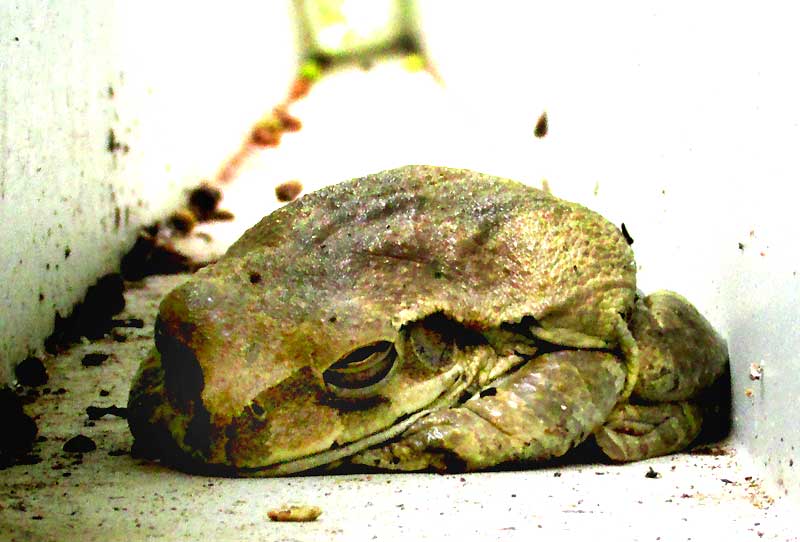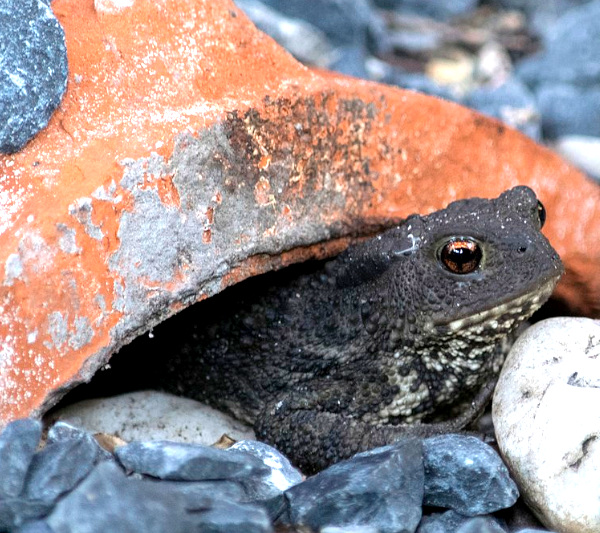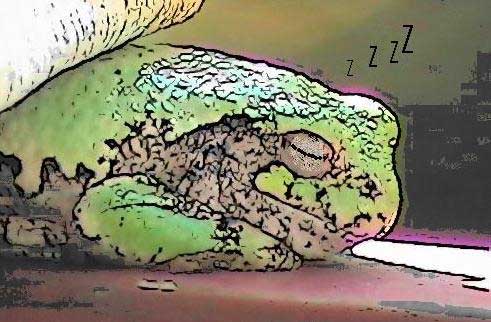HIBERNATION: The condition or period of an animal or plant spending the winter in a dormant state
ESTIVATION: The prolonged period of dormancy of an animal during a hot or dry period

Amphibian bodies can't do that. This is a real problem for all amphibians wherever big changes in temperature occur. The main way amphibians and other non-warm-blooded animals deal with this through hibernation during long cold periods, and estivation during long hot and/or dry times. The picture shows a Mexican Treefrog, Smilisca baudinii, estivating in a house's rain gutter during the Yucatan's long, hot dry season.
A HIBERNATION & ESTIVATION "CASTLE"

Paul van de Velde in the Netherlands has a garden next to a pond where he built a "castle" consisting of two roof-tile tunnels covered with sand topped with a layer of silt. The castle is visited by frogs, toads and salamanders who take shelter there -- all together -- both during the winter and summer's hottest days. At the left, in a picture provided by Paul, a Common Toad, Bufo bufo, peeps from a tunnel opening on a very hot summer day.
The message here is that sometimes in very simple ways we humans can help amphibians cope with their temperature problems.
HIBERNATION ON DRY LAND
Sometimes amphibians such as toads hibernate on land after digging below the frost line, possibly three feet or more! Certain salamanders may also hibernate deep below the ground's surface, but they can't dig the way toads can, so they must search for abandoned burrows or other natural holes.
Some frogs in the far north burrow under the forest floor's leaves and debris, and when freezing weather comes more than half of the water in their bodies goes out. Their veins fill with an antifreeze-like mixture of sugars and sugar alcohols, and then the dried-out frogs simply freeze. While frozen, ice forms around the frog's organs, but individual cells remain unfrozen and intact. Of course when the frog is frozen it doesn't breathe nor does its heart beat. Brain activity is immeasurable.
IN POND BOTTOMS
When cold weather comes many kinds of frogs swim to the bottoms of ponds and lakes where they rest on the bottom or partially burrow into the mud. Frogs have lungs and breathe air through nostrils, so why don't they drown when they stay on a lake's bottom all winter? It's because their highly specialized skin absorbs enough oxygen from the water, and gives off waste carbon dioxide the same way. Sometimes oxygen levels at pond bottoms drop so low that "winter kills" of frogs result.
Amphibian bodies when they hibernate do continue to burn energy, but their metabolic rates -- the rates at which the energy is burned -- slow down so much that they don't burn much. Many species can survive underwater for months, their bodies very slowly burning fat stored in their bodies.
Sometimes during the winter after a few unusually warm days hibernating amphibians become active and you may even hear frogs croaking. Sometimes the aquatic salamander called a mudpuppy moves about beneath the ice and ice-fishermen may catch them!
AMPHIBIAN PETS DURING THE WINTER
Amphibian pets kept warm indoors usually don't need to hibernate. However, some species need a period of dormancy before they can reproduce.
ESTIVATION
When amphibians estivate, their breathing, heart rate, and metabolic processes such as digestion all dramatically slow down. This decreases the organism's need for water. Some frogs and salamanders form a mucus cocoon around themselves to prevent water loss through their skin. When rains return, estivating organisms become active again.
